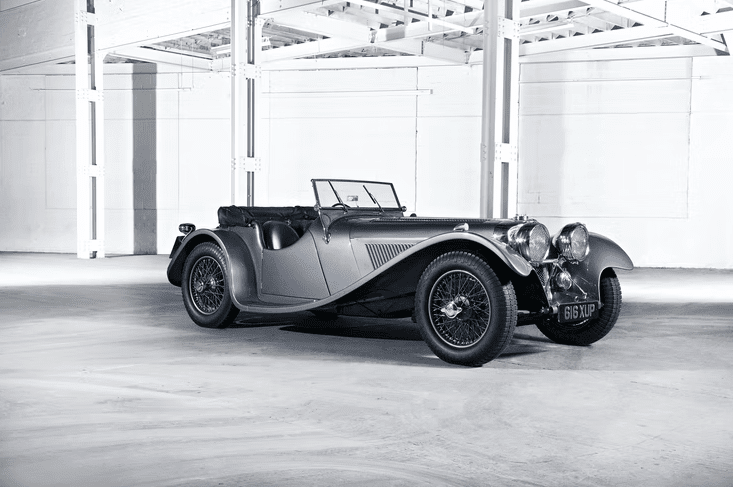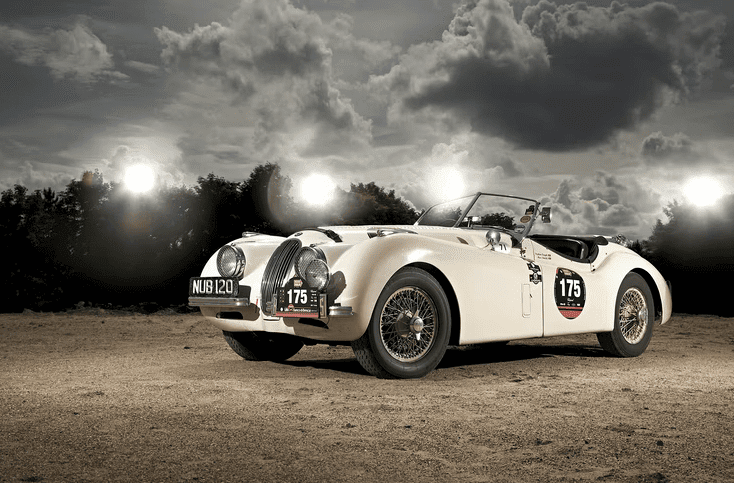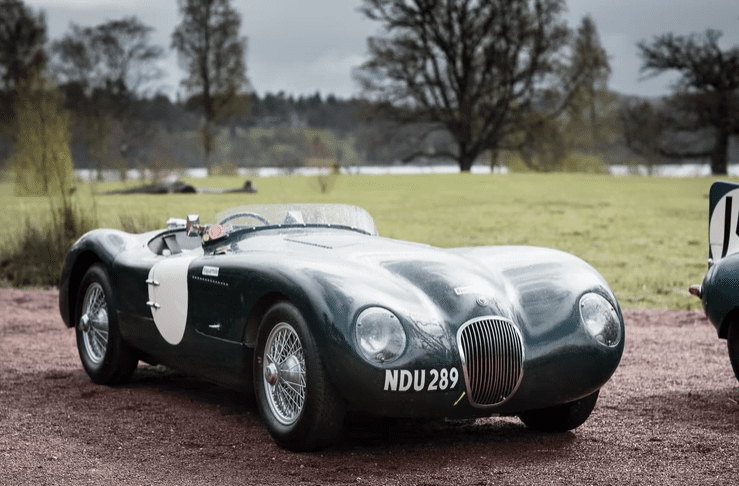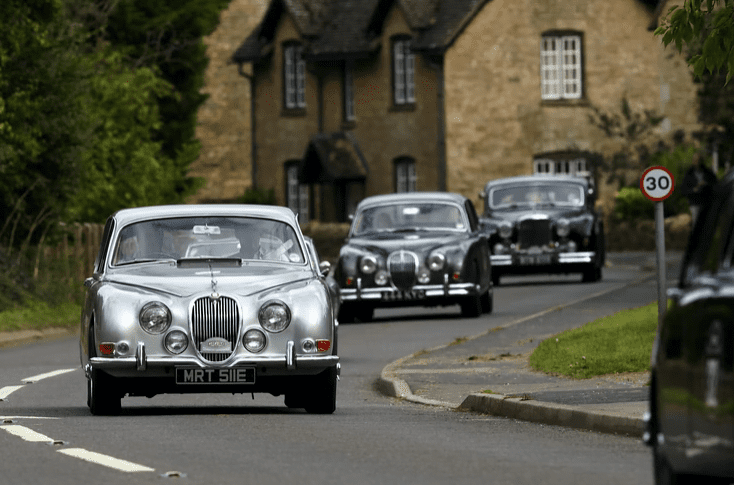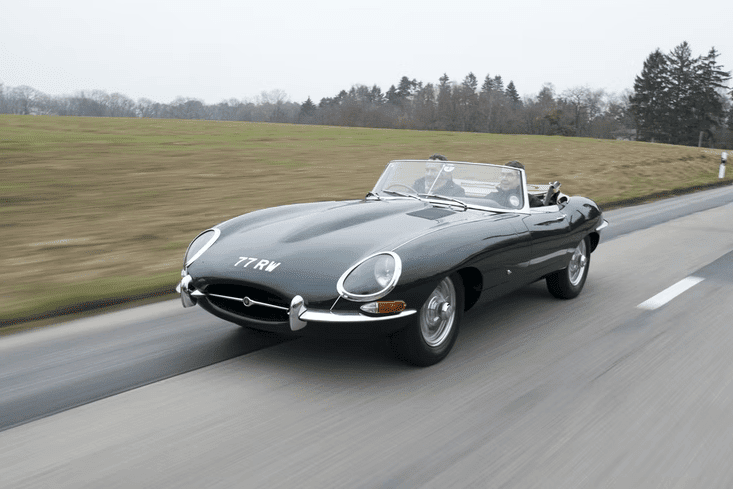A Run Down of The top 10 Most Iconic Jaguar Cars of All Time
Jaguar’s rich automotive heritage dates back to 1922 when it was established as the Swallow Sidecar Company. Originally specializing in manufacturing sidecars for motorcycles, the company quickly expanded its offerings to include stylish car bodies. Recognizing their potential, the founders, Sir William Lyons and William Walmsley, embarked on a journey to transform the company into a prominent automobile manufacturer.
In the 1930s, the Swallow Sidecar Company began producing sports cars based on popular models from other manufacturers. These vehicles showcased an exquisite blend of elegant design and exhilarating performance, setting the stage for Jaguar’s future endeavors. However, it wasn’t until the 1940s that the company adopted the name “Jaguar,” which was chosen to evoke the feline grace, agility, and power that would become synonymous with the brand.
Jaguar faced its share of challenges and setbacks throughout its history, including financial difficulties and ownership changes. Yet, despite these hurdles, the brand remained resilient and continued to create automotive marvels that captured the hearts of enthusiasts around the world.
One of Jaguar’s defining moments came in the 1950s with the introduction of the legendary Jaguar XK120. Boasting breathtaking aesthetics, cutting-edge technology, and exceptional performance, the XK120 quickly established itself as a true icon of the automotive world. It showcased Jaguar’s commitment to pushing the boundaries of design and engineering.
Building on the success of the XK120, Jaguar unveiled the iconic E-Type in the 1960s, a car widely regarded as one of the most beautiful vehicles ever created. Its sleek, aerodynamic lines, powerful engine, and luxurious interior made it a symbol of automotive excellence. The E-Type captured the imagination of car enthusiasts and became an instant classic, solidifying Jaguar’s reputation as a purveyor of timeless beauty and unrivaled performance.
Throughout the decades, Jaguar continued to produce remarkable cars, combining elegance with exhilarating driving experiences. The XJ series represented the pinnacle of luxury, while the XKE (known as the Jaguar E-Type in the United States) epitomized Jaguar’s prowess in sports car design.
In recent years, Jaguar has embraced electric mobility and advanced technologies while maintaining its commitment to exquisite craftsmanship and thrilling performance. The all-electric Jaguar I-PACE, introduced in 2018, exemplifies the brand’s forward-thinking approach, blending sustainable driving with the exhilaration expected from a Jaguar.
Jaguar’s enduring legacy lies not only in its exquisite designs but also in its unwavering pursuit of automotive excellence. From the early days as a sidecar manufacturer to its current position as a leading luxury car brand, Jaguar has consistently crafted vehicles that captivate the senses and ignite the passion of drivers worldwide.
Here are 10 of the most iconic Jaguars ever made.
1. Jaguar SS100
The SS100 holds a significant place in Jaguar’s illustrious history as one of their earliest and most captivating sports cars. Produced from 1936 to 1940, this two-seater model derived its name from the impressive claim that it could reach a top speed of 100 mph (hence the “100” in its name), an extraordinary feat for its time.
Renowned for its captivating beauty, the SS100 remains an enduring symbol of automotive elegance and grace. Its sleek lines, flowing curves, and attention to detail make it a timeless masterpiece. The SS100’s design exudes an air of sophistication and athleticism, capturing the imagination of car enthusiasts around the world.
Beyond its remarkable aesthetics, the SS100’s rarity adds to its allure. Due to the interruption caused by World War II, production of the SS100 was limited, making it a highly sought-after collector’s item today. Its scarcity further enhances its desirability among automotive connoisseurs and ensures its status as an icon of Jaguar’s early years.
The SS100 represents an era when Jaguar was establishing itself as a purveyor of exceptional performance cars, blending power, style, and innovation. While it laid the foundation for the brand’s future achievements, it remains an iconic representation of Jaguar’s commitment to creating vehicles that not only deliver exhilarating driving experiences but also captivate with their aesthetic beauty.
2. Jaguar XK120
After the tumultuous years of the Second World War, Jaguar made a resounding statement in the automotive world with the introduction of the XK120. This iconic sports car not only solidified Jaguar’s position as a prominent manufacturer but also captured the hearts and imaginations of car enthusiasts worldwide.
Unveiled in 1948 at the London Motor Show, the XK120 made an immediate impact with its stunning design and groundbreaking performance capabilities. Powered by a dual overhead camshaft inline-six engine, it boasted impressive power and speed, making it a formidable contender on both road and track. In fact, the XK120 held the distinction of being the fastest production car of its time, capable of reaching speeds exceeding 120 mph.
One particular XK120, known as NUB120, emerged as a legendary figure in the racing world. It became synonymous with triumph and resilience through its participation in the 1950 Alpine Rally, a grueling endurance road race that traversed multiple countries, including treacherous mountain passes. Behind the wheel was Ian Appleyard, who enlisted his wife Patricia “Pat” Lyons, the daughter of Jaguar founder Sir William Lyons, as his co-driver.
NUB120 demonstrated remarkable performance and resilience as it conquered the demanding challenges of the Alpine Rally. The duo’s skillful driving and the car’s exceptional capabilities propelled them to victory, etching their names in motorsport history. This triumph not only showcased the prowess of the XK120 but also cemented Jaguar’s reputation as a manufacturer capable of producing formidable racing machines.
The victory of NUB120 in the Alpine Rally exemplifies Jaguar’s commitment to engineering excellence and its dedication to motorsport success. The XK120, with its blend of stunning aesthetics, powerful performance, and remarkable achievements, became a symbol of Jaguar’s prowess and set the stage for the brand’s future endeavors in both the racing and luxury automotive realms.
3. Jaguar C-type
The Jaguar C-type, or XK120C, represents a pivotal moment in Jaguar’s racing legacy. Produced and available for sale from 1951 to 1953, this exquisite sports car made an indelible mark on the track while the XK120 was excelling in mountain rallies.
The C-type was born from the desire to create a purpose-built racing machine. Jaguar took the mechanical components of the XK120 and transplanted them into a dedicated racing chassis. Designed by engineer Bob Knight, the lightweight and robust multi-tube chassis formed the foundation of the C-type’s exceptional performance.
Under the hood, the C-type featured a 3.4-litre straight-six engine that produced an impressive 200 horsepower. This powerplant provided the C-type with the necessary thrust to compete and dominate on the racetrack. With its racing pedigree and enhanced performance, the C-type quickly became a force to be reckoned with in the world of motorsport.
The C-type’s aerodynamic design, characterized by its sleek lines and purposeful curves, further emphasized its racing prowess. It was a true embodiment of form following function, with every element contributing to its speed and agility. The C-type’s outstanding performance and striking appearance combined to create a visually stunning and formidable racing car.
The C-type’s success on the track was nothing short of remarkable. Notably, it secured Jaguar’s first victory at the prestigious 24 Hours of Le Mans endurance race in 1951, solidifying the brand’s reputation as a force in motorsport. The C-type’s triumph at Le Mans marked a significant milestone in Jaguar’s racing history, setting the stage for further victories and establishing Jaguar as a prominent name in international racing circuits.
The Jaguar C-type exemplifies the brand’s commitment to pushing the boundaries of automotive engineering and design. Its combination of lightweight construction, powerful performance, and aerodynamic excellence made it a true racing legend. Today, the C-type remains an icon of Jaguar’s racing heritage and serves as a testament to the brand’s unwavering pursuit of automotive excellence.
4. Jaguar D-type
The Jaguar D-type, manufactured from 1954 to 1957, stands as a true legend in the automotive realm. While it shared the same basic straight-six XK engine and several mechanical components with its predecessor, the C-type, the D-type introduced a revolutionary design that set it apart from its counterparts.
Under the guidance of the brilliant designer Malcolm Sayer, the D-type incorporated groundbreaking advancements inspired by the aviation industry. Its structure embraced innovative monocoque construction, which revolutionized the way competition cars were designed. This construction method utilized a single shell that integrated both the body and the chassis, resulting in exceptional rigidity and weight reduction.
Drawing inspiration from aeronautical principles, the D-type featured an aerodynamically efficient design. Every curve, contour, and surface was meticulously sculpted to optimize airflow and reduce drag. This focus on aerodynamic excellence allowed the D-type to slice through the air with remarkable efficiency, further enhancing its performance capabilities on the racetrack.
The D-type’s emphasis on aerodynamics and its aviation-inspired construction techniques propelled it to remarkable success in motorsport. In fact, the D-type secured three consecutive victories at the prestigious 24 Hours of Le Mans endurance race from 1955 to 1957, solidifying its status as an iconic racing car.
Beyond its victories on the track, the D-type’s influence on automotive design and technology cannot be overstated. Its pioneering use of monocoque construction and its innovative approach to aerodynamics brought aviation-inspired advancements to the world of competition car design. The D-type’s influence extended far beyond its racing achievements and left an indelible mark on automotive engineering.
The Jaguar D-type serves as a testament to Jaguar’s commitment to pushing the boundaries of design, technology, and performance. Its fusion of aviation and automotive excellence has made it an enduring symbol of innovation and achievement. The D-type’s legacy continues to inspire automotive enthusiasts and stands as a testament to Jaguar’s enduring pursuit of excellence on and off the racetrack.
5. Jaguar MK II
The Jaguar MKII, produced from 1959 to 1967, established a remarkable legacy on the touring car circuit, where modified versions of everyday road cars competed head-to-head. These races showcased the formidable performance of Jaguar’s small sedans and propelled the brand to great success in various racing championships.
Under private racing teams, the Jaguar MKII achieved notable victories in the British Saloon Car Championship (BSCC) between 1958 and 1963. These championships were fiercely contested, with the MKII consistently outperforming its rivals. Jaguar’s domination was not limited to first-place finishes; their cars often secured second and third positions as well, further demonstrating the MKII’s prowess and reliability on the track.
Beyond the borders of the United Kingdom, the Jaguar MKII continued its triumphs in international competitions. Notably, it achieved significant success in the Tour de France Automobile road race, winning the Touring Car class consecutively from 1959 to 1963. This grueling race tested both the endurance and performance of the competing vehicles, and the MKII’s consistent victories showcased its ability to excel in demanding and diverse racing conditions.
The Jaguar MKII’s achievements in both national and international touring car championships solidified its reputation as a force to be reckoned with in motorsport. The car’s combination of elegant design, powerful performance, and exceptional handling made it a formidable competitor on the track. Its successes contributed to Jaguar’s continued prominence in the racing world and further solidified the brand’s reputation for producing cars that combined luxury and performance.
The Jaguar MKII’s legacy serves as a testament to the brand’s commitment to engineering excellence and its ability to create vehicles that excel in both road-going and racing contexts. Its achievements continue to inspire and captivate automotive enthusiasts, highlighting Jaguar’s enduring pursuit of automotive excellence in all realms of performance
.
6. Jaguar E-type
The Jaguar E-Type, manufactured from 1961 until production ceased in 1975, remains an icon of automotive design and performance. Its introduction to the world sparked admiration and acclaim, with even Enzo Ferrari himself famously describing it as the most beautiful car in existence.
At the time of its launch, the automotive landscape was characterized by cars with drum brakes, average performance, and more conventional design approaches. The E-Type, however, brought forth a revolution with its cutting-edge features and stunning aesthetics.
The E-Type’s performance capabilities were nothing short of exceptional. Its top speed of 150 mph and impressive acceleration, achieving 0-60 mph in under 7 seconds, propelled it to the forefront of the sports car market. Jaguar achieved this remarkable performance through a combination of advanced engineering and innovative technologies.
The E-Type incorporated several groundbreaking features that set it apart from its competitors. Its monocoque construction provided enhanced rigidity and stability while minimizing weight. The adoption of disc brakes ensured exceptional stopping power, while the inclusion of rack and pinion steering contributed to precise handling and responsiveness.
Moreover, the E-Type boasted independent front and rear suspension, a feature that significantly enhanced its driving dynamics and comfort. The combination of these advanced components and technologies made the E-Type a true driver’s car, delivering an unparalleled experience on the road.
However, it was not only the E-Type’s performance that captivated enthusiasts; its looks were equally mesmerizing. Its sleek and aerodynamic silhouette, flowing lines, and sensuous curves made it an instant design icon. The E-Type’s timeless beauty transcended trends and generations, securing its place as one of the most iconic automotive designs in history.
The Jaguar E-Type revolutionized the sports car market, challenging conventions and raising the bar for performance and design. Its blend of exceptional speed, advanced engineering, and breathtaking aesthetics solidified its status as an automotive legend. Even today, the E-Type continues to evoke awe and admiration, embodying Jaguar’s unwavering commitment to pushing boundaries and creating extraordinary vehicles.
7. Jaguar XJ13
The Jaguar XJ13 holds a special place in automotive history as a rare and extraordinary gem. With only one example ever built, it stands as a testament to Jaguar’s ambition and engineering prowess.
Designed by the legendary Malcolm Sayer, the XJ13 was intended to be Jaguar’s contender for the renowned 24 Hours of Le Mans endurance race. This extraordinary machine showcased cutting-edge technology and design elements that set it apart from its contemporaries.
One of the most notable features of the XJ13 was its utilization of the 5.0-litre V12 engine, marking the first time Jaguar employed this powerful and refined powerplant. The V12 engine brought with it a remarkable level of performance, combining smooth power delivery with impressive horsepower. Its presence under the XJ13’s sleek hood promised exhilarating performance on both the track and the open road.
The XJ13’s stunning design captured the imagination of enthusiasts around the world. Sayer’s meticulous attention to aerodynamics resulted in a visually captivating machine. Its flowing lines, curvaceous bodywork, and purposeful stance made it a sight to behold. Every aspect of the XJ13’s design was meticulously crafted to optimize aerodynamic efficiency and enhance its performance potential.
While the XJ13 was built with the intention of competing at Le Mans, it never had the opportunity to showcase its capabilities in a racing setting. However, its legacy lives on as a testament to Jaguar’s engineering excellence and design innovation. The XJ13 remains a symbol of what could have been—a glimpse into the potential of Jaguar’s racing endeavors during that era.
Today, the XJ13 stands as an irreplaceable piece of automotive history and a testament to Jaguar’s unwavering pursuit of automotive excellence.
8. XJ6 S1
The release of the Jaguar XJ6 Series 1 in 1968 marked a significant milestone for the brand, as it garnered widespread acclaim and accolades. Notably, the XJ6 Series 1 received the prestigious “Car of the Year” award, solidifying its status as a groundbreaking and exceptional vehicle.
From 1970 onwards, the XJ6 became Jaguar’s flagship model, representing the pinnacle of the brand’s luxury saloons. It embodied the spirit of Jaguar’s commitment to elegance, performance, and innovation.
One notable aspect of the XJ6 Series 1 is that it was the last Jaguar saloon to bear the influence of Sir William Lyons, the visionary founder of the company. Lyons’ involvement ensured that his uncompromising standards of design, craftsmanship, and attention to detail were incorporated into the XJ6.
The XJ6 Series 1 captured the essence of Jaguar’s DNA, blending timeless elegance with refined performance. Its sleek lines, graceful proportions, and luxurious interior showcased Jaguar’s commitment to producing vehicles that exuded both style and substance.
Under the hood, the XJ6 Series 1 featured a range of powerful engines, offering a balance of performance and smoothness that became synonymous with the Jaguar brand. This combination of power, comfort, and handling prowess contributed to the XJ6’s reputation as a superior luxury saloon.
Throughout its production years, the XJ6 underwent several updates and improvements, evolving into subsequent generations that retained the essence of the original while incorporating modern advancements. The XJ range has remained a flagship model for Jaguar, representing the brand’s dedication to luxury, innovation, and driving excellence.
The XJ6 Series 1, with its association with Sir William Lyons and its award-winning status, holds a significant place in Jaguar’s history. It symbolizes the brand’s commitment to excellence and the legacy of one of the automotive industry’s most influential figures.
9. Jaguar XJR-9
The Jaguar XJR-9 stands as a legendary race car that brought Jaguar back to the forefront of motorsport glory. Designed by Tony Southgate and constructed by Tom Walkinshaw Racing (TWR), the XJR-9 was purpose-built to compete in both FIA Group C and IMSA Camel GTP racing categories. Its debut at the 1988 24 Hours of Daytona marked the beginning of a remarkable era for Jaguar.
At the heart of the XJR-9 lay a formidable Jaguar 7.0-litre V12 engine. Based on the production 5.3-litre engine found in the Jaguar XJS road car, this race-tuned powerplant produced an astonishing 750 horsepower. The sheer potency of the engine propelled the XJR-9 to extraordinary speeds and exhilarating performance on the track.
The XJR-9’s capabilities were put to the ultimate test in endurance racing, notably at the iconic 24 Hours of Le Mans. This grueling race demanded not only speed but also durability and strategic prowess. In 1988, the XJR-9 accomplished what Jaguar had been longing for since 1957—it triumphantly crossed the finish line, securing victory and reestablishing Jaguar’s dominance at Le Mans.
The success of the XJR-9 was a testament to its exceptional engineering, advanced aerodynamics, and the expertise of the TWR team. With its sleek and purposeful design, the XJR-9 cut through the air with precision, delivering optimal performance and stability. Its triumph at Le Mans elevated Jaguar’s standing in the world of motorsport and added to the brand’s rich racing legacy.
The Jaguar XJR-9 not only celebrated Jaguar’s return to the top of the podium but also showcased the brand’s commitment to pushing the limits of automotive engineering and performance. It became an emblem of Jaguar’s relentless pursuit of excellence and a symbol of their victorious spirit. The XJR-9 holds an esteemed place in Jaguar’s history, reminding us of their storied racing heritage and the thrill of competition on the world’s most challenging tracks.
10. Jaguar XJ220
The Jaguar XJ220 represents the epitome of automotive engineering and performance during its production years from 1992 to 1994. This two-seater supercar, born out of a collaboration between Jaguar and TWR (Tom Walkinshaw Racing), not only pushed the boundaries of speed and technology but also captivated the imagination of car enthusiasts worldwide.
Upon its release, the XJ220 claimed the title of the world’s fastest car, a testament to its remarkable capabilities. Powering this formidable machine was a 3.5-litre twin-turbocharged V6 engine that unleashed an impressive 540 horsepower. The combination of advanced engineering, aerodynamics, and power allowed the XJ220 to achieve remarkable acceleration and a top speed of 212.3 mph (341.7 km/h), as recorded during testing by Jaguar.
Beyond its extraordinary performance, the XJ220 showcased stunning design and craftsmanship. Its sleek and aerodynamic body, with sweeping lines and sculpted curves, exuded an air of elegance and power. Every aspect of its design was meticulously crafted to optimize aerodynamic efficiency and enhance the driving experience.
The XJ220’s limited production run and exclusivity added to its allure. With only a select number of units built, each XJ220 became a rare and coveted masterpiece. Its rarity, coupled with its exceptional performance and striking aesthetics, established the XJ220 as an icon of automotive excellence.
While the XJ220 represents a remarkable achievement for Jaguar, it also symbolizes the brand’s commitment to pushing boundaries and embracing innovation. By combining cutting-edge technology, superior performance, and captivating design, Jaguar created a supercar that not only thrilled drivers but also left an indelible mark on automotive history.
The Jaguar XJ220 continues to hold a special place in the hearts of enthusiasts and collectors alike, representing the pinnacle of Jaguar’s engineering prowess and the pursuit of automotive perfection. Its legacy stands as a testament to the brand’s unwavering commitment to creating exceptional vehicles that embody the spirit of Jaguar.
FAQ: Jaguar Cars
How much is a Jaguar?
The price of a Jaguar can vary depending on the model, trim level, optional features, and location. Jaguars range in price from entry-level models starting around $40,000 to high-performance luxury vehicles that can exceed $100,000.
Is a Jaguar expensive?
Jaguars are generally considered luxury vehicles, and their pricing reflects that. While they may have a higher price tag compared to some mainstream car brands, the cost can be justified by the premium features, performance, and craftsmanship offered by Jaguar.
Who are Jaguar cars made by?
Jaguar cars are made by Jaguar Land Rover Automotive PLC, a British multinational automotive company. Jaguar is a part of the Jaguar Land Rover (JLR) group, which is owned by Tata Motors, an Indian automotive manufacturer.
Is Jaguar better than BMW?
The comparison between Jaguar and BMW depends on individual preferences and priorities. Both brands offer a range of luxury vehicles with their unique features and characteristics. Some may prefer the design and performance of a Jaguar, while others may prefer the engineering and driving dynamics of a BMW. It’s recommended to test drive both brands and consider personal preferences before making a decision.
Which brand is better, Jaguar or Mercedes?
Determining whether Jaguar or Mercedes is better depends on individual preferences, needs, and priorities. Both brands have a reputation for producing high-quality luxury vehicles, each with its own strengths and characteristics. It’s advisable to test drive models from both brands and consider factors such as design, performance, technology, and reliability to determine which brand aligns better with your preferences.
Are Jaguar cars good quality?
Yes, Jaguar cars are generally regarded as having good quality. Jaguar has made significant strides in improving reliability and build quality in recent years. However, as with any car brand, individual models and model years may vary in terms of quality and reliability. It’s recommended to research specific models and read reviews from owners and experts to assess the quality of a particular Jaguar model.
Why are older Jaguars so cheap?
The lower prices of older Jaguars can be attributed to factors such as depreciation, maintenance costs, and perceived reliability issues associated with certain older Jaguar models. As luxury vehicles age, their value tends to decrease, making them more affordable in the used car market. Additionally, the cost of maintaining and repairing older Jaguars may deter some buyers, contributing to the lower prices.
What are Jaguar cars known for?
Jaguar cars are known for their elegant and distinctive design, luxurious interiors, refined performance, and a combination of sportiness and sophistication. Jaguar has a heritage of producing stylish and high-performance vehicles, often associated with a sense of prestige and British automotive craftsmanship.
Is a Jaguar XF a reliable car?
The reliability of a Jaguar XF can vary depending on factors such as the specific model year, maintenance history, and individual vehicle condition. Overall, the Jaguar XF has generally improved in terms of reliability in recent years, but it’s advisable to research and consider factors such as consumer reviews and expert ratings to assess the reliability of a particular Jaguar XF model.


